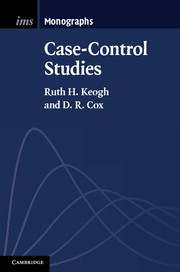Book contents
- Frontmatter
- Contents
- Preface
- Preamble
- Notes
- 1 Introduction to case-control studies
- 2 The simplest situation
- 3 Matched case-control studies
- 4 A general formulation
- 5 Case-control studies with more than two outcomes
- 6 Special sampling designs
- 7 Nested case-control studies
- 8 Case-subcohort studies
- 9 Misclassification and measurement error
- 10 Synthesis of studies
- Appendix: A theoretical diversion
- References
- Index
1 - Introduction to case-control studies
Published online by Cambridge University Press: 05 April 2014
- Frontmatter
- Contents
- Preface
- Preamble
- Notes
- 1 Introduction to case-control studies
- 2 The simplest situation
- 3 Matched case-control studies
- 4 A general formulation
- 5 Case-control studies with more than two outcomes
- 6 Special sampling designs
- 7 Nested case-control studies
- 8 Case-subcohort studies
- 9 Misclassification and measurement error
- 10 Synthesis of studies
- Appendix: A theoretical diversion
- References
- Index
Summary
• A case-control study is a retrospective observational study and is an alternative to a prospective observational study. Cases are identified in an underlying population and a comparable control group is sampled.
• In the standard design exposure information is obtained retrospectively, though this is not necessarily the case if the case-control sample is nested within a prospective cohort.
• Prospective studies are not cost effective for rare outcomes. By contrast, in a case-control study the ratio of cases and controls is higher than in the underlying population in order to make more efficient use of resources.
• There are two main types of case-control design; matched and unmatched.
• The odds ratio is the most commonly used measure of association between exposure and outcome in a case-control study.
• Important extensions to the standard case-control design include the explicit incorporation of time into the choice of controls and into the analysis.
Defining a case-control study
Consider a population of interest, for example the general population of the UK, perhaps restricted by gender or age group. We may call a representation of the process by which exposures X and outcomes Y occur in the presence of intrinsic features W the population model. As noted in the Preamble, such a system may be investigated prospectively or retrospectively; see Figure 1.1. In a prospective or cohort study a suitable sample of individuals is chosen to represent the population of interest, values of (W, X) are determined and the individuals are followed through time until the outcome Y can be observed.
Information
- Type
- Chapter
- Information
- Case-Control Studies , pp. 8 - 30Publisher: Cambridge University PressPrint publication year: 2014
